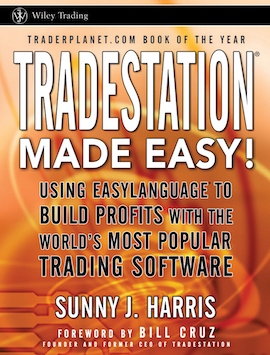 In 2019, my trading started to turn more into quantitative style. First, I backtested ideas manually with charts and spreadsheets, then switched to AmiBroker. I’d been thinking of signing up to TradeStation, a popular trading software and brokerage since the ’90s. Even though AmiBroker Formula Language (AFL) differs from EasyLanguage (EZL) by TS, the process of programming trading systems and backtesting is quite similar. I have been learning to use TradeStation software for the past few months. I can’t say if it’s better than AmiBroker, but maybe I’ll publish a comparison in a future post. This post is about the book in title which teaches to program in EasyLanguage and was published in 2011.
In 2019, my trading started to turn more into quantitative style. First, I backtested ideas manually with charts and spreadsheets, then switched to AmiBroker. I’d been thinking of signing up to TradeStation, a popular trading software and brokerage since the ’90s. Even though AmiBroker Formula Language (AFL) differs from EasyLanguage (EZL) by TS, the process of programming trading systems and backtesting is quite similar. I have been learning to use TradeStation software for the past few months. I can’t say if it’s better than AmiBroker, but maybe I’ll publish a comparison in a future post. This post is about the book in title which teaches to program in EasyLanguage and was published in 2011.
Markets change but the core principles remain
The author lays out many trading strategies as examples but also points that the book is not about how to make money, but about how to code in EasyLanguage by TradeStation. I never take any strategy right off a book or a blog to trade it, and I definitely wouldn’t consider using an automated strategy from a book published that many years ago. With all respect, it’s not the issue of the content but while reading it, I was thinking how different the markets were back in the days when HFT was yet to start dominating the electronic markets, therefore a retail trader could code and automate intraday strategies at home with more ease compared to today. It feels that markets moved a lot slower back then, hence less price noise. However, it doesn’t devalue the book because EasyLanguage has stood the test of time and readers can still learn to code their own ideas.
Getting the basics right and trying out TradeStation features
I like the way Sunny starts the book with some simple basics about TradeStation, math and coding. She explains in simple terms what the software and EZL can do, then gets more into the nitty-gritty of the Function, Indicator, PaintBar, ShowMe and Strategy features of TradeStation. The author goes step by step through the various parts of using the software with quite easy to understand code examples that the reader can try right away in TS. I suggest to install TradeStation on your computer before starting with the book to make the experience practical.
Tips and tricks from the pros
There is a chapter about TradeStation experts and some of their tricks. Sunny has featured Larry Williams, Perry Kaufman, Linda Raschke, Bill Brower, Murray Ruggiero and others in the book with references to their sources. Most of the names are already familiar to me as I’ve studied their materials before.
Optimization comes after you have a working strategy
She finishes the book with the Optimization feature and measuring the performance of a trading system. Having backtested strategies myself, it’s always mindful to read about another researcher’s requirements for sample size and lookback period to compare it to my own. I usually say there’s no right or wrong way to analyze or trade the market, but when it comes to backtesting and optimizing a strategy, then actually it’s easy to curve-fit data to find something working in the past that can break down fast going into the future. The author explains this thought process in the book and gives her suggestions how to properly optimize a trading strategy. She introduces the CPC index to evaluate the success of a system by multiplying win rate, profit factor and average win / loss ratio – three metrics I use myself to sum up trading results.
I recommend this book to anyone starting out with EasyLanguage in TradeStation. However, I felt to grasp the content of this book better thanks to having expertise in technical trading and IT background with some basic knowledge of programming. Even though the book is meant for beginners, be patient and take a chapter at a time if you’re a beginner in quantitative trading.
TradeStation Made Easy! by Sunny J. Harris book link
Share this post